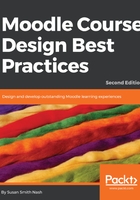
The advantages of Moodle
We'll start with the question, "Why Moodle?" What does it have to offer course designers, trainers, and educators? First and foremost, as educators ourselves, we can say that the fact that Moodle is built around an instructional ideal or educational philosophy makes it pretty exceptional. More specifically, Moodle's design is driven by a social constructionist pedagogy as inspired by educational theorists such as Vygotsky, Papert, and others. Social constructionism is a view of education that relies on the belief that people create knowledge through the process of constructing artifacts, including text, media, or other such projects, within a social environment. In short, this means that the creator of Moodle, Martin Dougiamas, built Moodle based on the idea that people learn best when they have an opportunity to construct, share, collaborate, and learn with others. As we discuss Moodle's features, we'll see many ways in which this philosophy is exhibited.
In today's world of distributed communication, where people connect with each other through their mobile devices and use social media to communicate and collaborate, the original Moodle foundation of social constructionism makes more sense than ever.
We could even go as far as to say that in our social media world, meaning and reality are often suspended until they are validated by the social media presence. It is no longer a rather hypothetical process that results in the social construction of reality, but a more direct statement: the thing does not exist until it is validated by our group (on social media). This may seem a bit harsh, but that is the way we have directed our technology to take us, and although we claim to live in a world that values individualism, we do not trust it when it comes to education, community, or enterprise. So, Moodle is again absolutely perfect for our world at this time.
Despite a strong pedagogical foundation, Moodle doesn't lock you into one way of teaching, which is another advantage of Moodle. It offers an array of choices when it comes to how you construct and deliver your course. In fact, we use this flexibility as the foundation for how this book is organized, with chapters devoted to a few of the more common ways that Moodle is used. Some are heavily reliant on social constructionist strategies, and others, less so. If you want to create a self-paced, content-driven course, Moodle can do that. If you need to facilitate a cohort-based, student-centered course, Moodle can do that too. Likewise, if you want to offer a very structured, linear course or, at the opposite end of the spectrum, manage a community, we think you'll find Moodle to be accommodating.